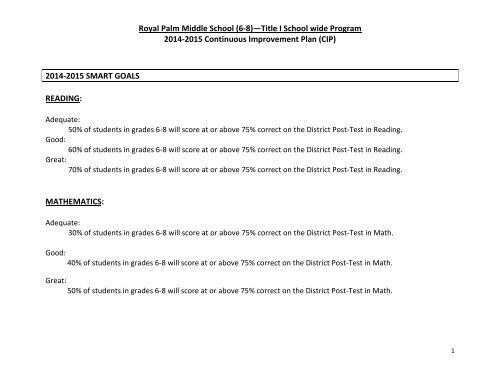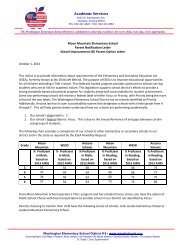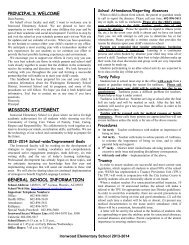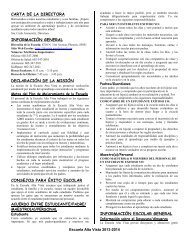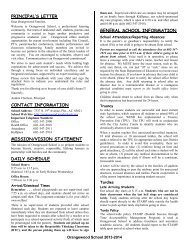Royal Palm Middle School - Washington Elementary School District 6
Royal Palm Middle School - Washington Elementary School District 6
Royal Palm Middle School - Washington Elementary School District 6
- No tags were found...
You also want an ePaper? Increase the reach of your titles
YUMPU automatically turns print PDFs into web optimized ePapers that Google loves.
<strong>Royal</strong> <strong>Palm</strong> <strong>Middle</strong> <strong>School</strong> (6-8)—Title I <strong>School</strong> wide Program2014-2015 Continuous Improvement Plan (CIP)2014-2015 SMART GOALSREADING:Adequate:50% of students in grades 6-8 will score at or above 75% correct on the <strong>District</strong> Post-Test in Reading.Good:60% of students in grades 6-8 will score at or above 75% correct on the <strong>District</strong> Post-Test in Reading.Great:70% of students in grades 6-8 will score at or above 75% correct on the <strong>District</strong> Post-Test in Reading.MATHEMATICS:Adequate:30% of students in grades 6-8 will score at or above 75% correct on the <strong>District</strong> Post-Test in Math.Good:40% of students in grades 6-8 will score at or above 75% correct on the <strong>District</strong> Post-Test in Math.Great:50% of students in grades 6-8 will score at or above 75% correct on the <strong>District</strong> Post-Test in Math.1
STRATEGY—<strong>School</strong> Leadership Providing strong leadership<strong>Royal</strong> <strong>Palm</strong> <strong>Middle</strong> <strong>School</strong> (6-8)—Title I <strong>School</strong> wide Program2014-2015 Continuous Improvement Plan (CIP)Effective <strong>School</strong> Leadership Action Steps: A shared vision and mission based on student achievement is evident throughout the <strong>Royal</strong> <strong>Palm</strong> school. Decision making that is focused on the school vision and mission is shared with teachers, staff, and the communityby monthly newsletters, the staff Weekly Navigator, Site Council, Teacher Leadership Team (formerly SteeringCommittee) and the Title I informational meeting. The principal at <strong>Royal</strong> <strong>Palm</strong> <strong>School</strong> participates in the planning and delivery of job embedded professional learningto include intervention meetings, data meetings, Arizona College and Career Ready Standards trainings, learningwalks, teacher evaluation training, CIP development, and strategic planning. <strong>School</strong> and district leadership will use the teacher and principal evaluation system to drive professional learningopportunities. Teachers, principals and district administrators will participate in collaborative conversations tomake connections between the WESD Roadmap of High Expectations for Student Learning and the TeacherEvaluation Instrument or the Principal Evaluation Instrument with the aim of increasing teacher and principaleffectiveness and student academic achievement. Examples are teacher surveys, exit slips, observations, walkthrough, and lesson plans. The principal ensures an equitable, respectful, and supportive environment that is focused on promoting highachievement expectations for all students by setting clear expectations and celebrating student success as evidencedby the quarterly academic recognitions, and encouraging growth by displaying student progress toward AR goals.Students are also encouraged to maintain A’s and B’s on their report cards to earn Grand Raiders which can be usedon reward field trips throughout the year. Students are recognized quarterly for their year-long achievement in ourHonor’s Assembly.2
<strong>Royal</strong> <strong>Palm</strong> <strong>Middle</strong> <strong>School</strong> (6-8)—Title I <strong>School</strong> wide Program2014-2015 Continuous Improvement Plan (CIP)STRATEGY—Strengthen Instruction for All StudentsReading and Math Action Steps: The Title I whole school reform model is Response to Intervention (RTI).Instruction is provided by Highly Qualified teachers in each class. Equitable distribution of effective teachers is ensured through the WESD hiring process and principal collaborationwith the Human Resources department All students in grade 6 receive Tier I reading instruction in a ninety-minute, uninterrupted block, using the researchbased,district-adopted reading program: Harcourt Story Town. All students in grades 7-8 grade students receive Tier I reading instruction in a sixty-minute, uninterrupted blockusing the research-based, district-adopted reading program: McDougal-Littell. All students in all grades receive differentiated small group reading instruction every day from a Highly Qualifiedteacher or para-professional. For students in grades 6-8, teachers will implement the research-based, district-adopted math program: ConnectedMath Project 3 (CMP3). Teachers will refine math journaling practices utilizing notebooks/composition books to include written constructedresponse to support and defend answers.3
<strong>Royal</strong> <strong>Palm</strong> <strong>Middle</strong> <strong>School</strong> (6-8)—Title I <strong>School</strong> wide Program2014-2015 Continuous Improvement Plan (CIP)STRATEGY: STRENGTHEN INSTRUCTION FOR ALL STUDENTS, continued All teachers* will develop and use daily lesson plans based on the Arizona College and Career Ready Standards(AZCCRS) and student data. Lesson plans are developed using WESD Governing Board-adopted instructionalmaterials and the WESD Roadmap criteria for lesson planning. WESD lesson plans include three essential attributes:1. Grade level objectives; 2. Instructional strategies/learning activities; and 3. Assessments/outcomes. [SEI class andIILP lesson plans are based on and coded to match AZ English Language Proficiency (ELP) standards.] *“AllTeachers” from this point forward in the document refers to: general education, special education, StructuredEnglish Immersion (SEI), special area and Academic Intervention Specialists. All teachers post daily content and language objectives that state what students will know and be able to do instudent-friendly language. Teachers use the objectives to communicate clear learning expectations to students atthe beginning of the lesson; to reinforce the expectations verbally and visually throughout the lesson; and to assesslearning outcomes at the end of the lesson. The district school improvement initiative (using data-driven instruction, aligned with the AZCCRS and guided bythe WESD Roadmap) supports schools in implementing and maintaining a systematic and continual data cycle ofassessing students and analyzing multiple sources of data, such as: screening tests (i.e., DIBELS Next); diagnostictests (i.e., Individual Reading Inventory (IRI) and the Phonics Screener); the AZELLA for ELL students, WESD Pre- andPost-Assessments in reading and math; and WESD interim assessments in reading and math. <strong>School</strong>s focus theirdata cycle on effective lesson design based on the data analysis, effective delivery of instruction with high levels ofstudent engagement, regular monitoring of student progress, providing timely feedback to students and parentsand celebrating growth.4
<strong>Royal</strong> <strong>Palm</strong> <strong>Middle</strong> <strong>School</strong> (6-8)—Title I <strong>School</strong> wide Program2014-2015 Continuous Improvement Plan (CIP)STRATEGY: STRENGTHEN INSTRUCTION FOR ALL STUDENTS, continued Best First Instruction (Tier I, provided to all students) is based on what students know and are able to do and will besupported with 90 cumulative minutes per week of structured teacher collaboration meetings to analyze dataand/or plan instruction. Best First Instruction is data-driven, guided by the WESD Roadmap, based on districtadoptedcurriculum resources and aligned with the AZCCRS. Tier I instruction is designed and implemented to meet the needs of 80-90% of students, by:o Providing large group and differentiated small group instruction;o Facilitating high levels of student engagement;o Providing students with multiple representations and explanations, as well as multiple means ofdemonstrating learning;o Checking for understanding using strategies and questions that promote complex and critical thinking(designed using Depth of Knowledge (DOK) taxonomy);o Measuring student progress frequently;o Using assessment data to adjust instruction; ando Providing timely corrective and positive feedback to students. Job embedded professional development at <strong>Royal</strong> <strong>Palm</strong> <strong>Middle</strong> <strong>School</strong> is facilitated by the school administrators,school program coach, district administrators, and outside consultants for all teachers, and is provided in theseways: <strong>School</strong> Professional Learning Community (PLC) trainings, collaborative data analysis and instructionalplanning meetings and on-going coaching. During these meetings, grade level teams will have time to report, planand reflect on lessons, assessments and student performance, and request assistance as needed.5
<strong>Royal</strong> <strong>Palm</strong> <strong>Middle</strong> <strong>School</strong> (6-8)—Title I <strong>School</strong> wide Program2014-2015 Continuous Improvement Plan (CIP)STRATEGY: STRENGTHEN INSTRUCTION FOR ALL STUDENTS, continued Job-embedded professional development will use the WESD Roadmap, district curriculum resources (e.g., gradelevel program guides and pacing guides), district assessments and student data results to increase the consistencyof:o Effective lesson planning;o Effective delivery of instruction, including the implementation of rigorous instructional strategies/learningactivities;o Use of assessment data to inform instruction and intervention; ando Creating a purposeful learning culture. All teachers will continue to receive job-embedded professional development:o In the AZCCRS for Math, including the embedded use of the Standards for Mathematical Practice: 1. Makesense of problems and persevere in solving them; 2. Reason abstractly and quantitatively; 3. Construct viablearguments and critique the reasoning of others; 4. Model with mathematics; 5. Use appropriate toolsstrategically; 6. Attend to precision; 7. Look for and make use of structure; 8. Look for and express regularityin repeated reasoning;o Designed to increase math content knowledge and the consistency of effective implementation of districtadoptedmath curriculum resources (including the use of three-part lesson plans and anchor charts) and toincrease student proficiency in flexible problem solving and math journaling practices that include writtenconstructed response to support and defend answers.6
<strong>Royal</strong> <strong>Palm</strong> <strong>Middle</strong> <strong>School</strong> (6-8)—Title I <strong>School</strong> wide Program2014-2015 Continuous Improvement Plan (CIP)STRATEGY: STRENGTHEN INSTRUCTION FOR ALL STUDENTS, continued All teachers will continue to receive job-embedded professional development:o In the AZCCRS for English Language Arts (ELA) and Literacy in History/Social Studies, Science, and TechnicalSubjects, including the ELA Instructional Shifts: 1. Regular practice with complex texts and their academiclanguage; 2. Reading, writing and speaking, grounded in evidence from texts, both literary andinformational; and 3. Building knowledge through content-rich nonfiction;o Designed to increase the consistency of effective implementation of district-adopted reading and EnglishLanguage Arts curriculum resources and to increase student proficiency in close reading and comprehendingof complex literary and informational texts. Principal, program coach, instructional coaches, other administrators, and/or district office staff will continueclassroom walk-throughs and observations of teachers during whole and small group instruction, to providefeedback, coaching and/or modeling of highly effective teaching practices.7
<strong>Royal</strong> <strong>Palm</strong> <strong>Middle</strong> <strong>School</strong> (6-8)—Title I <strong>School</strong> wide Program2014-2015 Continuous Improvement Plan (CIP)STRATEGY: INTERVENTION PROGRAM FOR STRUGGLING STUDENTS, continued Students identified as needing Tier II targeted interventions, continue to receive supplementary instruction in fluidand flexible groups based on multiple sources of data, from a Highly Qualified Academic Intervention Specialistand/or a Highly Qualified para-professional. (If the interventionist’s schedule allows Tier II direct services, thenstudents will receive interventions from the teacher.) Intervention staff will keep accurate records that specify TierII students by grade, amount of weekly intervention time, progress monitoring dates and data, and interventionexit date based on data-validated criteria. <strong>School</strong>s will implement a clearly defined process to monitor intervention effectiveness, and move students in andout of interventions based on the data results, including weekly progress monitoring for Tier III students andongoing progress monitoring for Tier II students. Job-embedded time will be provided for data analysis and instructional planning to increase the consistency ofeffective differentiation of instruction and interventions targeted to meet the learning needs of individual studentsand subgroups of students in reading and math. Curriculum, instruction and assessment of English Language Learner (ELL) students will meet ADE requirements. ELL students receive instruction in the Structured English Immersion (SEI) four-hour model* or through theimplementation of Individual Language Learner Plans (ILLP) in a mainstream classroom. *Four-Hour Model: 1. OralConversation and Vocabulary; 2. Reading; 3. Writing; 4. Grammar. Students will be identified by the After <strong>School</strong> Academy for reading and math interventions based on relevant data.AIMS scores were used to identify students who were 10 points deficit on their scaled score to meeting. Studentsalso have the opportunity to receive tutoring services before and after school.9
STRATEGY—Data-driven Decision MakingReading and Math Action Steps:<strong>Royal</strong> <strong>Palm</strong> <strong>Middle</strong> <strong>School</strong> (6-8)—Title I <strong>School</strong> wide Program2014-2015 Continuous Improvement Plan (CIP) Systematic assessment and data collection processes will ensure data-driven decision-making within a continuousdata cycle, including:o Establishing aggressive, transparent goals for student growth prior to each interim assessment;o Administering interim assessments according to the published assessment calendar;o Implementing 90 cumulative minutes per week of structured teacher collaboration meetings to analyze dataand/or for planning instruction;o Producing explicit, documented action commitments during each collaboration meeting;o Developing “acceleration” plans for appropriate students base on results of data analysis;o Planning and implementing instruction based on data analysis and acceleration plans;o Reassessing and analyzing results and adjusting instruction accordingly; ando Monitoring key school-wide and grade level goals at least monthly. The district school improvement initiative (using data-driven instruction, aligned with the AZCCRS and guided bythe WESD Roadmap) supports schools in implementing and maintaining a systematic and continual data cycle ofassessing students and analyzing multiple sources of data, such as: screening tests (i.e., DIBELS NEXT); diagnostictests (i.e., Individual Reading Inventory (IRI) and the Phonics Screener); the AZELLA for ELL students, WESD Pre- andPost-Assessments in reading and math; and WESD interim assessments in reading and math. <strong>School</strong>s focus theirdata cycle on effective lesson design based on the data analysis, effective delivery of instruction with high levels ofstudent engagement, regular monitoring of student progress, providing timely feedback to students and parentsand celebrating growth.10
<strong>Royal</strong> <strong>Palm</strong> <strong>Middle</strong> <strong>School</strong> (6-8)—Title I <strong>School</strong> wide Program2014-2015 Continuous Improvement Plan (CIP)STRATEGY: DATA-DRIVEN DECISION MAKING, continued Administrators and teachers will meet at the beginning of the school year to review state and district assessmentdata in order to identify trends and areas of strength and weakness by grade level. Grade level teachers then meetfor a deeper analysis of scores. Grade level teams share findings with the whole faculty and/or in vertical gradelevel teams in order to group students and plan lessons that will meet the needs of individual students andsubgroups of students. By the first week in September, Professional Learning (PLC) time will be provided for grade level teams to analyzedata for instructional planning that meets the Tier I, II and III needs of individual students and subgroups ofstudents including data from these assessments: DIBELS Next, Scholastic Reading Inventory (SRI) for new students,Success Maker, WESD Reading and Math Pre-Tests. Job embedded professional development for all teachers in data analysis and data-driven instructional planning willbe facilitated by principal and school program coach. Assessment data in reading and math will be collected and accurate data records will be maintained by JeffWilliams and Jo Ann Brass, Program Coaches. Accurate data records include specifying Tier II and Tier III studentsby grade, amount of weekly intervention time, assessment dates and data, and program exit date based on datavalidatedcriteria. Data results will determine student movement/exit or continued services at the current Tier.11
<strong>Royal</strong> <strong>Palm</strong> <strong>Middle</strong> <strong>School</strong> (6-8)—Title I <strong>School</strong> wide Program2014-2015 Continuous Improvement Plan (CIP)STRATEGY—Coordinated and Comprehensive ServicesGeneral Action Steps: The school provides information to stakeholders regarding the integration of student and family support programs,including school resources and various resources within WESD and other groups available to assist within ourschool/district community such as: <strong>School</strong> social worker, Parent Liaison, Nutrition Services, the After <strong>School</strong>Academy Program. The school collaborates with the Facility Use Coordinator to provide space to groups who seek community-basedlocations for their events such as: Madison Blast-USSSA (Baseball), Knights Football (NYS), Young Champions(Cheer), Open Door Fellowship Church. The school develops relationships with stakeholders to promote fostering a safe and encouraging environment forlearning with a focus on student achievement in school and responsible behaviors in the community. <strong>School</strong> leadership continues building relationships with community agencies and businesses to assist students andfamilies such as John C. Lincoln Hospital, Villa Del Sol, Marley House, Desert Mission Food Bank, Peter Piper Pizza,Fuddruckers, and Castles N’ Coasters. The social worker/counselor/ Principal and other staff will coordinate student and family needs with available SocialServices within the district. The social worker/Health Technician’s job duties supports the social, emotional, and physical well-being of studentsand families and primary responsibilities are as follows: Referrals to community resources, assists with students whoare truant, go on home visits with the principal or district security team, provide group sessions to deal with a varietyof student issues such as bullying, social skills, and drug awareness.12
<strong>Royal</strong> <strong>Palm</strong> <strong>Middle</strong> <strong>School</strong> (6-8)—Title I <strong>School</strong> wide Program2014-2015 Continuous Improvement Plan (CIP)STRATEGY: COORDINATED AND COMPREHENSIVE SERVICES, continuedGeneral Action Steps: <strong>School</strong> staff including the Health Technician, Office Manager, Social Worker and Parent Liaison will continue tosupport families in need through referrals to outside agencies, and clothing stocked through the generousdonations of community partners. The implementation of the Arizona College and Career Ready Standards (AZCCRS) prioritizes instruction gearedtowards diminishing drop-out thinking and behaviors among our students and parents at all grade levels. Allmembers of the staff are charged with reinforcing drop-out prevention by maintaining a learning atmosphere thatreassures and assists stakeholders in believing in and achieving success in high school, college and career. Beginning at grade 8 students will research and write about academic and career interests. Eighth grade students will participate in EXPLORE, an ACT curriculum-based educational and career planningprogram that includes an assessment, the development of a pre-high school ECAP, and professional developmentfor teachers and administrators.Positive <strong>School</strong> Climate Focused on Achievement Action Steps: High expectations for academic achievement for all students are evident throughout the school environment asevidenced by use of district grading protocol, parent communication for students at –risk, parent portal andwebsites, progress reports. The school environment is driven by a clear plan for school safety and codes of conduct for staff and students whichis communicated to parents in the Parent/Student Handbook. Practices on site that support safety and appropriateconduct are transparent; staff and students share a common language in regards to these expectations andbehaviors; and data related to the plan is reflected in a reduction in the number of disciplinary actions related tostaff and student conduct and school safety in comparison to the previous school year.13
<strong>Royal</strong> <strong>Palm</strong> <strong>Middle</strong> <strong>School</strong> (6-8)—Title I <strong>School</strong> wide Program2014-2015 Continuous Improvement Plan (CIP)STRATEGY: COORDINATED AND COMPREHENSIVE SERVICES, continuedPositive <strong>School</strong> Climate Focused on Achievement Action Steps: <strong>Royal</strong> <strong>Palm</strong> <strong>Middle</strong> <strong>School</strong>’s school-wide discipline plan conforms to the WESD discipline policy as outlined in theWESD Parent Student Handbook. In addition, we utilize positive reinforcement in the form of reward coupons(Raiders), which can be redeemed for field trips and items in the Raider Store. This supports student achievementin reading and math by reinforcing students’ focus on academic tasks. Raiders are used to motivate and encourageappropriate behavior and work ethic. Discipline plans are explicit, communicated with students, parents and staff.Procedures reflect equity and a respect for diversity in all areas. The physical environment is clean and orderly in classrooms, library, labs, halls, restrooms, offices, playgrounds,cafeteria, parking lots and all common areas of the campus, inside and outdoors. Transitions from elementary to middle school are supported by fifth grade visitations in the spring which includeSTAR testing.Bridging from middle school to high school is provided by articulation meetings between the staffs of the GlendaleHigh <strong>School</strong> Union and <strong>Royal</strong> <strong>Palm</strong>. Students also have an opportunity to attend a summer program – ProjectSharp. High school counselors come to our campus in the spring for question/answer sessions and registration inthe spring. Students are encouraged to attend the Future Freshmen events provided by the high schools.Family and Community Engagement Action Steps: The school’s Parent Involvement Policy is reviewed by the staff, steering committee, and site council and availableto parents through the website and handouts in the office.14
<strong>Royal</strong> <strong>Palm</strong> <strong>Middle</strong> <strong>School</strong> (6-8)—Title I <strong>School</strong> wide Program2014-2015 Continuous Improvement Plan (CIP)STRATEGY: COORDINATED AND COMPREHENSIVE SERVICES, continuedFamily and Community Engagement Action Steps: The school invited families and community members to attend our annual Title I Parent Information Night onAugust 6, 2014 to learn more about our school, Title I programs in reading and math and ways to become activelyinvolved in their children’s education at <strong>Royal</strong> <strong>Palm</strong> <strong>School</strong>. Teachers review the Title I Parent-Student Compact at fall Parent/Teacher Conferences to gain support for studentlearning and parent involvement. Families are invited to participate in school activities and programs to include: Meet the Teacher Night, OpenHouse, Title I Information Night, extracurricular games and performances, club events, Academy Awards, ParentUniversity, Literacy/Math Night, and Coffee Talks. Families are informed of opportunities that may help students who struggle in school including Literacy/MathNights, After <strong>School</strong> Academy, Parent University, and VAMOS.Families and community members are invited and encouraged to participate in school improvement efforts byparticipating in Site Council, PTO, joining Business Advisory Team, volunteering, donating, and communicatingopenly with the school and district.<strong>School</strong> personnel actively seek out community participation in school activities and planning through invitationsfrom the social worker, program coaches and administration, outreach specialists, PTO, etc.Parent and family engagement strategies focused on increasing student achievement include offering childcarewhen possible, sharing information in primary languages, offering translation/interpreters as needed, engagingsmall groups of parents with their students in practicing reading and math, providing materials to strengthenreading and math comprehension, inviting parents to campus for parent informational evenings.15
<strong>Royal</strong> <strong>Palm</strong> <strong>Middle</strong> <strong>School</strong> (6-8)—Title I <strong>School</strong> wide Program2014-2015 Continuous Improvement Plan (CIP)STRATEGY—Plan Development, Implementation, and EvaluationAction Steps: The district, with external technical assistance, provides support to the school in Continuous Improvement Plan(CIP) development by providing information about ADE requirements and recommendations, and by suggesting keyelements that align the school plan with the WESD Roadmap and with the <strong>District</strong> Continuous Improvement Plan.<strong>Royal</strong> <strong>Palm</strong> <strong>School</strong> is identified as SW1 and programs included in our <strong>School</strong> wide Title I budget are:Before and after school tutoring, purchasing technology to increase use of Success Maker within the classroom,providing a math night for parents to learn more about the new curriculum adoption and how they can help theirchild at home, securing substitutes for classroom coverage to allow teachers to go on learning walks, conduct teamplanning and data analysis. Funding for staffing that supports reading and/or math is provided through Title I and includes: Staffing for ourAcademic Intervention Specialist(s) to support Tier 3 and 2 students as well as funding for the Program Coach whosupports teacher instructional proficiency through modeling, using job embedded professional learningopportunities to strengthen instruction, facilitating data and curriculum meetings for varied grade levels. Our Title Ibudget also includes staffing for paraprofessionals to instructionally assist in our Read 180 and Enrichment Readingclasses. Funding for <strong>Royal</strong> <strong>Palm</strong> that supports reading and math is provided through Title I. Positions funded byTitle I grant include: 2.0 FTE for Academic Intervention Specialists in Math, 1.0 FTE Social Worker, and 0.750 FTEParaprofessional Title I Assistant. Implementation of the plan involves the development of the plan by the leadership team, implementation of theplan by the principal working collaboratively with the program coaches to provide meaningful professionaldevelopment for staff. The teachers will use the information and knowledge learned in the professionaldevelopment sessions to plan their instruction by analyzing assessment data and in using the common core andproviding effective interventions.16
<strong>Royal</strong> <strong>Palm</strong> <strong>Middle</strong> <strong>School</strong> (6-8)—Title I <strong>School</strong> wide Program2014-2015 Continuous Improvement Plan (CIP)STRATEGY—Plan Development, Implementation, and Evaluation, continued: CIP planning committee members include program coaches, administration, intervention staff, and teachers on theTeacher Leadership Team/Steering Committee. Tasks include examining school data, analyzing the results anddetermining the next steps needed to meet our goals. <strong>Royal</strong> <strong>Palm</strong> <strong>School</strong> and WESD conduct an annual evaluation of findings from the WESD CIRT (ContinuousImprovement Review Team) and other data which are used to develop strategic plans for the next school year.17


